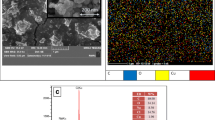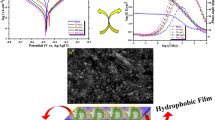Abstract
Carbon quantum dots are fluorescent nanoparticles with various unique properties such as environmental friendliness, high conductivity, low toxicity and high stability. This study aimed to synthesize carbon nanodots (CDs) from chitosan and apply them as a corrosion inhibitor in BIS 2062 carbon steel. CDs were synthesized from chitosan, and their morphological characteristics studied using atomic force microscopy (AFM) and transmission electron micrograph (TEM). The AFM and TEM results showed that the CD had a spherical shape and 2D structure. The FTIR spectroscopy results indicated that the CDs were rich in C=O and C–O functional groups. The UV–Vis spectroscopic analysis showed absorption peaks at 288 and 222 nm. Moreover, the zeta potential was positive. The BIS 2062 carbon steel, which is used for boat building, was coated with CDs, and its electrochemical characteristics were studied through linear sweep voltammetry (LSV) and electrochemical impedance spectroscopy (EIS). The LSV and EIS results showed that steel coupons coated with 0.05% CD had excellent corrosion resistance. Cyclic voltammetric evaluation using glassy carbon electrode revealed that the oxidation and reduction potential of iron oxide were significantly suppressed due to the coating of CDs. The results highlighted the use of CDs as a corrosion inhibitor and a potential alternative to graphene-based materials.








Similar content being viewed by others

References
Amjadi M, Hallaj T, Asadollahi H, Song Z, de Frutos M, Hildebrandt N (2017) Facile synthesis of carbon quantum dot/silver nanocomposite and its application for colorimetric detection of methimazole. Sensor Actuat B Chem 244:425–432
Ashraf PM, Thomas SN, Edwin L (2016) Development of graphene–nanometre-sized cerium oxide-incorporated aluminium and its electrochemical evaluation. Appl Nanosci 6(2):149–158
Cao LI, Meziani MJ, Sahu S, Sun YP (2012) Photoluminescence properties of graphene versus other carbon nanomaterials. Acc Chem Res 46(1):171–180
Chowdhury D, Gogoi N, Majumdar G (2012) Fluorescent carbon dots obtained from chitosan gel. RSC Adv 2(32):12156–12159
De B, Karak N (2013) A green and facile approach for the synthesis of water soluble fluorescent carbon dots from banana juice. RSC Adv 3(22):8286–8290
Ding H, Wei JS, Zhong N, Gao QY, Xiong HM (2017) Highly efficient red-emitting carbon dots with gram-scale yield for bioimaging. Langmuir 33(44):12635–12642
Dong Y, Pang H, Yang HB, Guo C, Shao J, Chi Y, Li CM, Yu T (2013) Carbon-based dots co-doped with nitrogen and sulfur for high quantum yield and excitation-independent emission. Angew Chem Int Ed 52(30):7800–7804
Ðorđević L, Arcudi F, D’Urso A, Cacioppo M, Micali N, Bürgi T, Purrello R, Prato M (2018) Design principles of chiral carbon nanodots help convey chirality from molecular to nanoscale level. Nat Commun 9(1):3442.15
Dumée LF, He L, Wang Z, Sheath P, Xiong J, Feng C, Tan MY, She F, Duke M, Gray S, Pacheco A (2015) Growth of nano-textured graphene coatings across highly porous stainless steel supports towards corrosion resistant coatings. Carbon 87:395–408
Hola K, Bourlinos AB, Kozak O, Berka K, Siskova KM, Havrdova M, Tucek J, Safarova K, Otyepka M, Giannelis EP, Zboril R (2014) Photoluminescence effects of graphitic core size and surface functional groups in carbon dots: COO− induced red-shift emission. Carbon 70:279–286
Janus Ł, Piątkowski M, Radwan-Pragłowska J, Bogdał D, Matysek D (2019) Chitosan-based carbon quantum dots for biomedical applications: synthesis and characterization. Nanomaterials 9(2):274
Li X, Wang H, Shimizu Y, Pyatenko A, Kawaguchi K, Koshizaki N (2010) Preparation of carbon quantum dots with tunable photoluminescence by rapid laser passivation in ordinary organic solvents. Chem Commun 47(3):932–934
Lim SY, Shen W, Gao Z (2015) Carbon quantum dots and their applications. Chem Soc Rev 44(1):362–381
Liu X, Pang J, Xu F, Zhang X (2016) Simple approach to synthesize amino-functionalized carbon dots by carbonization of chitosan. Sci Rep 6:31100
Mohapatra S, Rout SR, Das RK, Nayak S, Ghosh SK (2016) Highly hydrophilic luminescent magnetic mesoporous carbon nanospheres for controlled release of anticancer drug and multimodal imaging. Langmuir 32(6):1611–1620
Pavan AS, Ramanan SR (2016) A study on corrosion resistant graphene films on low alloy steel. Appl Nanosci 6(8):1175–1181
Pourhashem S, Ghasemy E, Rashidi A, Vaezi MR (2018) Corrosion protection properties of novel epoxy nanocomposite coatings containing silane functionalized graphene quantum dots. J Alloy Compd 731:1112–1118
Sahu S, Behera B, Maiti TK, Mohapatra S (2012) Simple one-step synthesis of highly luminescent carbon dots from orange juice: application as excellent bio-imaging agents. Chem Commun 48(70):8835–8837
Shen J, Zhu Y, Chen C, Yang X, Li C (2011) Facile preparation and upconversion luminescence of graphene quantum dots. Chem Commun 47:2580–2582
Shen J, Zhu Y, Yang X, Zong J, Zhang J, Li C (2012) One-pot hydrothermal synthesis of graphene quantum dots surface-passivated by polyethylene glycol and their photoelectric conversion under near-infrared light. New J Chem 36(1):97–101
Song J, Zhao L, Wang Y, Xue Y, Deng Y, Zhao X, Li Q (2018) Carbon quantum dots prepared with chitosan for synthesis of CQDs/AuNPs for iodine ions detection. Nanomaterials 8(12):1043
Tabak M, Armon R, Neeman I (1999) Cinnamon extracts’ inhibitory effect on Helicobacter pylori. J Ethnopharmacol 67(3):269–277
Vasimalai N, Vilas-Boas V, Gallo J, de Fátima Cerqueira M, Menéndez-Miranda M, Costa-Fernández JM, Diéguez L, Espiña B, Fernández-Argüelles MT (2018) Green synthesis of fluorescent carbon dots from spices for in vitro imaging and tumour cell growth inhibition. Beilstein J Nanotech 9(1):530–544
Wang C, Xu Z, Cheng H, Lin H, Humphrey MG, Zhang C (2015) A hydrothermal route to water-stable luminescent carbon dots as nanosensors for pH and temperature. Carbon 82:87–95
Xu X, Ray R, Gu Y, Ploehn HJ, Gearheart L, Raker K, Scrivens WA (2004) Electrophoretic analysis and purification of fluorescent single-walled carbon nanotube fragments. J Am Chem Soc 126(40):12736–12737
Yang W, Ratinac KR, Ringer SP, Thordarson P, Gooding JJ, Braet F (2010) Carbon nanomaterials in biosensors: should you use nanotubes or graphene? Angew Chem Int Ed 49(12):2114–2138
Yang Y, Cui J, Zheng M, Hu C, Tan S, Xiao Y, Yang Q, Liu Y (2012) One-step synthesis of amino-functionalized fluorescent carbon nanoparticles by hydrothermal carbonization of chitosan. Chem Commun 48(3):380–382
Yang D, Ye Y, Su Y, Liu S, Gong D, Zhao H (2019) Functionalization of citric acid-based carbon dots by imidazole toward novel green corrosion inhibitor for carbon steel. J Clean Prod 229:180–192
Zhu H, Wang X, Li Y, Wang Z, Yang F, Yang X (2009) Microwave synthesis of fluorescent carbon nanoparticles with electrochemiluminescence properties. Chem Commun 34:5118–5120
Zhu S, Song Y, Zhao X, Shao J, Zhang J, Yang B (2015) The photoluminescence mechanism in carbon dots (graphene quantum dots, carbon nanodots, and polymer dots): current state and future perspective. Nano Research 8(2):355–381
Acknowledgement
The author sincerely thanks the Director, ICAR Central Institute of Fisheries Technology for providing facilities. Thanks are also due to Dr. Leela Edwin, Head, Fishing Technology Division, Technical staff of the Division, Dr MM Prasad, Head, MFB Division and Sophisticated Technology Instrumentation Centre, CUSAT for extending support and guidance, FTIR and SEM facilities, respectively.
Funding
This research did not receive any specific grant from funding agencies in the public, commercial, or not-for-profit sectors.
Author information
Authors and Affiliations
Corresponding author
Ethics declarations
Conflict of interest
The authors report no declarations of interest.
Electronic supplementary material
Below is the link to the electronic supplementary material.
Rights and permissions
About this article
Cite this article
Keerthana, A.K., Ashraf, P.M. Carbon nanodots synthesized from chitosan and its application as a corrosion inhibitor in boat-building carbon steel BIS2062. Appl Nanosci 10, 1061–1071 (2020). https://doi.org/10.1007/s13204-019-01177-0
Received:
Accepted:
Published:
Issue Date:
DOI: https://doi.org/10.1007/s13204-019-01177-0



